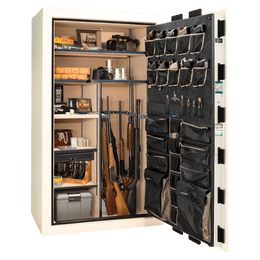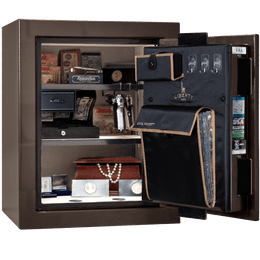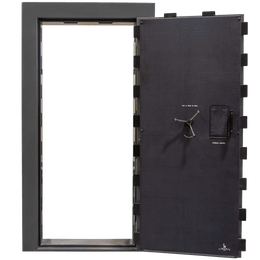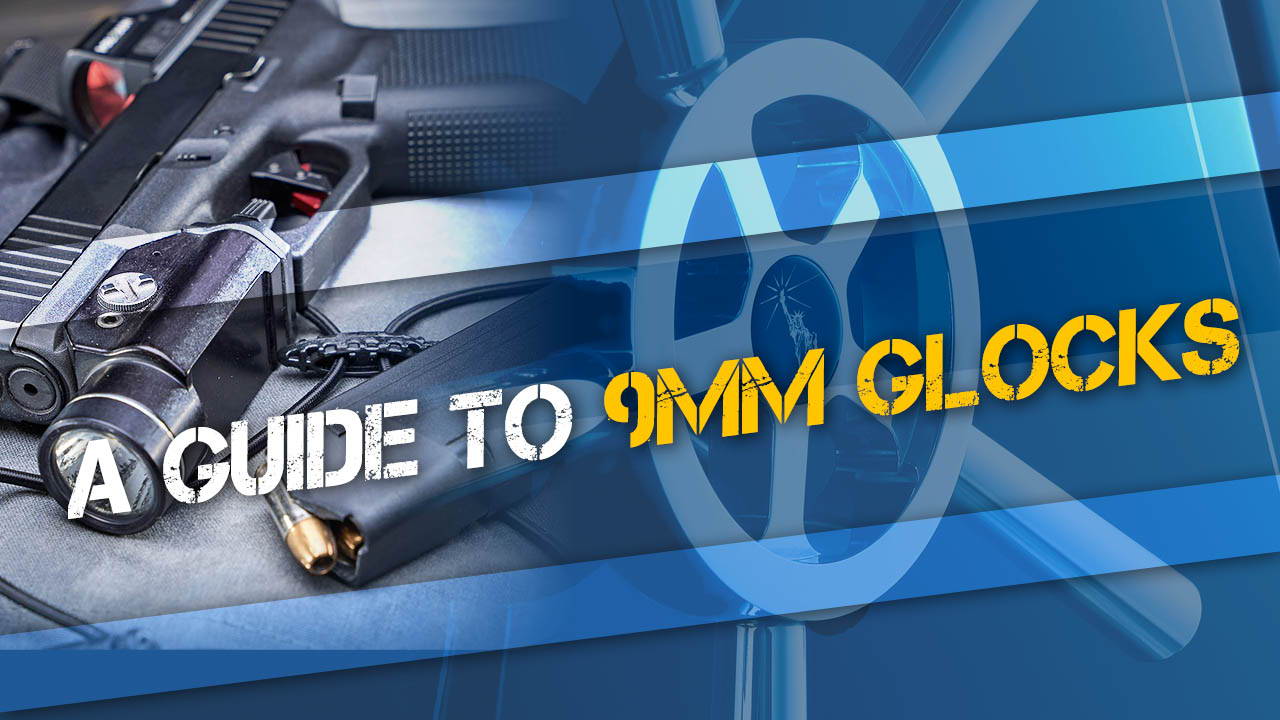According to most experts, Glocks are the most popular handguns in the world, with over 20 million made so far. Credible reports suggest Glock maintains around a 65% market share in the US law enforcement and civilian handgun market, with an estimated 1 million-plus Glocks sold in the USA each year.
The company supplies pistols to militaries and police forces around the globe, and for good reason. The Glock is an elegantly simple, reliable, and durable handgun.
The first Glock model ever made was in 9mm Parabellum caliber (also known as 9x19mm, 9mm Luger, or simply 9mm), and the Glock models chambered for this cartridge remain by far the most popular sellers.
In this article, we will go over all the 9mm Glock models and discuss their differences in size, capacity, intended use, and features.
Image courtesy of Lucky Gunner
What is a Glock?
A Glock is a semi-automatic, polymer-framed, striker-fired handgun made by GLOCK, Inc. and GLOCK Ges.m.b.H. The Glock pistol is known for its reliability, durability, and relatively simple design. A Glock has only around 35 parts, compared to 52+ in Colt 1911 or 61 in Beretta 92FS.
Gaston Glock founded the business in 1963 in Deutsch-Wagram, Austria, where the original manufacturing facility still stands. Before developing his pistol, Gaston’s company made entrenching tools, knives, grenade casings, machine-gun belts, and other products for the Austrian military, but no firearms. Today Glock offers roughly 30 different models and hundreds of sub-variants.
Still, all follow the general function and mode of operation and vary only in the finish, caliber, length of barrel/slide, length of the grip, overall width, and ammunition capacity, in addition to variations in capability for mounting optics, tactical lights, and interchangeable backstraps. A common tongue-in-cheek saying is, “If you’ve seen one Glock, you’ve seen them all.
Nearly all 9mm Glocks are now available in MOS (Modular Optic System) variants that allow the mounting of micro-compact red dot optics on the slide, and several “C” models have been offered over the years, with compensating gas ports cut into the barrels and slides, though these are comparatively rare.
Glock Preventative Maintenance Manual
Where are Glocks made?
Glock pistols are made in Austria, USA, and Slovakia. Historically, most Glocks that have been sold were made in Austria. Over the years, the company has expanded dramatically. In addition to GLOCK Ges.m.b.H. in Deutsch-Wagram, Austria, today Glock’s other facilities include GLOCK Ges.m.b.H. in Ferlach, Austria, GLOCK s.r.o in Bratislava, Slovakia, and GLOCK, Inc., in Smyrna, Georgia, in the USA. The Smyrna location was founded in 1986 as the first subsidiary of GLOCK Ges.m.b.H.
Mr. and Mrs. Glock are still involved in the operation of the company. Since 2013, many Glocks intended for the American market have been made in Glock’s Smyrna, Georgia, plant in the USA. Nearly all Glocks sold domestically are made in the USA or Austria. The Glock 42 (.380 ACP caliber) is made exclusively in the USA.
Common types of Glock in 9x19mm Parabellum caliber
Glocks (the company prefers to use all-capitals, as in GLOCK 17, but it’s pretty annoying to write and read that way, so we’ll be a bit informal here) are available in at least 8 calibers from the factory (with aftermarket barrels available that fire specialized cartridges). Still, by far, the most popular is the 9mm Glocks. There are quite a few models and variations of Glock in 9mm, so let’s see if we can break it down for you.
Glock 17: The first commercially available Glock in the US
The Glock 17 was the first commercially available Glock model sold in America, starting in January 1986. The pistol had been adopted by the Austrian army and police forces (in 1983) and by Norway (in 1985) as the P80—see below for more. The G17 is a full-size service pistol with a 4.5-inch barrel, 8-inch overall length, 5.47” height, a slide width of 1 inch, and overall width of 1.26 inches at its widest. It weighs a relatively feathery 22 ounces without its loaded magazine inserted and a still-light 33-ish ounce loaded (depending on your choice of ammunition).
According to the Glock company, the Glock 17 was so named because its design was the 17th patent filed by Gaston Glock. We’ve done some research and have never been able to substantiate this assertion, and it doesn’t matter too much. However, the magazine capacity of the standard Glock 17 is, you guessed it, 17 rounds (today, optional extended magazines are available in 19, 24, 31, and 33-round capacities). When it was introduced to the American market, nearly all other service-sized semi-automatic pistols had 15-round magazine capacities, and many cops were still using 6-shot revolvers. Hence, 17 rounds was impressive and in our view, is the likely actual reason for choosing 17 as the model number.
The Glock 17 was one of the first commercially available pistols to utilize a polymer frame (and was certainly the first successful one), which caused much controversy and misunderstanding over its first few years on the market. In a famous quote from Die Hard 2, Detective John McClane tells a stuck-up airport cop, “That punk pulled a Glock 7 (sic) on me. Do you know what that is? It’s a porcelain gun made in Germany. It doesn't show up on your airport X-ray machines here and costs more than you make in a month.” This scene, along with many unsubstantiated rumors circulated by the media, led some people to believe that the polymer-framed Glock pistols could pass through metal detectors and airport security checkpoints, which is simply untrue.
Initially, gun writers and industry VIPs of the time were critical of the Glock 17, its blocky, space-age look, its “plasticky” feel, and its “Safe-Action” striker-fired trigger, which was called “mushy” or simply “horrible” by people who were used to the crisper, single-action trigger break afforded by 1911s, Berettas, and SIGs of the day. However, those who carried and used the Glock 17 were quickly won over by the new pistol’s soft-shooting characteristics, lightweight, reliability, accuracy, and durability. Additionally, police officers transitioning from double-action .38 Special or .357 Magnum service revolvers found the new Glock trigger to be “very light and steady,” They quickly learned to shoot the new plastic fantastic well.
Detail stripping and swapping parts in the new Glock was child’s play compared to the Berettas, SIGs, Smith & Wesson, and revolvers of the time, and armorers loved the Glock’s remarkably simple design that permitted swapping all internal parts across different guns without any hand-fitting or gunsmithing in most cases. The black nylon-filled polymer frame didn’t get as hot as metal-framed guns in the sun, nor did it feel cold in frigid temperatures. According to Small Arms Solutions, the Glock 17 platform demonstrated a hitherto unknown mean rounds between failure performance of 11,000 rounds in military trials. Moreover, the Glock 17 had no issues with a steady diet of +P and +P+ high-pressure 9mm ammunition, while some of the other pistols of the day would quickly be battered to death by its use.
Another selling point is the compatibility of magazines among the various sizes of Glock 9mms. Assuming the same double-stack 9mm frame type, all larger/longer magazines will fit and function in shorter frames (see below). For example, the full-length or extended G17 magazines fit and function in G19s and G26es; G19 magazines fit and function in the G26, etc. (See below for details on each model.)
This performance, combined with a very aggressive marketing campaign aimed at the US government and police agencies, helped Glock make serious inroads in the market. By the end of the 1990s, an estimated 60-80 percent of US police agencies were issuing Glock pistols.
The Glock 17 is still one of the most popular models for the brand, though its slightly smaller brother, the compact sized Glock 19 (see below), has become the perennial number-one seller over the past couple of decades. The G17 is not a small pistol, with roughly the same external dimensions as the bulky Beretta 92 series. Still, it can be concealed with the right gear and clothing and is very popular among competition, recreational shooters, and law enforcement.
Glock 19: The best-selling Glock in history
In 1988, Glock introduced the Glock 19, the first compact sized pistol in the Glock family. If you started with a Glock 17 and cut a half-inch off the barrel and slide and a half-inch off the grip, you’d end up with the Glock 19. The G19 has the same width as the G17, but its shorter grip frame and magazine limit its standard capacity to 15+1 rounds, and it has a 4-inch barrel. Weighing in at just over 21 ounces without a magazine and just over 30 ounces loaded, this midsize Glock has proven exceptionally popular with law enforcement and civilian shooters. It strikes an excellent balance between shootability and concealability. Over the last couple of years, the G19 has just edged out the excellent (and comparatively tiny) SIG P365 as the best-selling handgun in America, and it hits this mark nearly every year by most estimations.
The Glock 19 is also likely the most often-recommended handgun by experts who are asked by friends, students, and acquaintances about what’s the best handgun for concealed carry? The G19 is a solid choice for most people, with its excellent reliability, shootability, accuracy, ease of use, and goldilocks, not-too-big, not-too-small size.
Glock 19X: A military contract submission, but for civilians
The G19X is the civilian variant of the pistol that Glock submitted to the US Army’s XM17 Modular Handgun System (MHS) competition in 2016 to determine the handgun that would replace the Army’s aging Beretta M9. The 19X was the first Glock to use a shorter Glock-19-sized slide and 4-inch barrel on a full-sized (modified) Glock 17 frame, a style of pistol Glock now refers to as a crossover model.
Glock didn’t win the competition (some say because they ignored some of the requirements, but Glock argues that SIG undercut them on price), and the SIG P320 was selected as the winner, now adopted as the M17 and M18 pistols.
The true Glock MHS pistols (Glock submitted G17, G19, G22, and G23 variants) had manual thumb safeties added, an extended-length front strap without finger grooves or half-moon cutouts, and a lanyard loop, as well as flat-dark-earth (FDE) colored magazines. In 2018, Glock released a commercial version they called the G19X, which has nearly all of the features of the MHS pistols, minus the manual safeties.
Due to its unique, overhanging front strap, the G19X is the only standard size clock that requires a specific magazine (floorplate); The extended magazine floorplates on the latest Gen 5 magazines prevent insertion into the G19X, so only earlier-generation magazines are compatible. This didn’t hinder sales of the model, which sold 100,000 copies in its first 6 months of release to the public.
Glock later introduced the Glock 45, which is essentially the same size frame and slide/barrel as the G19X, only without the 19X’s unique magwell/front strap and lanyard loop, and offered in the standard Glock colors rather than the 19X’s Flat Dark Earth (though nowadays the G19X is also available in black). See below for more on the G45.
Glock 26: The first “sub-compact” Glock
The G26, released in 1996, was the first of the sub-compact Glocks, intended for deep concealment or frequent concealed carry. To create the G26, Glock took the shortened Glock 19 (compared to the Glock 17) and shortened it even more dramatically, with another half-inch plus lopped off the barrel (final length is 3.43 inches), a shorter slide to match, and around 0.8” cut off the grip frame. With an overall length of 6.5 inches and a height of just over four inches, the G26 packs 10 rounds of 9mm in its stubby, flush-fit magazine and weighs just over 25 ounces loaded. Since its grip circumference, slide width, trigger reach, and controls are identical to its bigger brethren, the G19 and G17, the G26 makes an excellent backup weapon for police officers, military, or government agents who are issued the full- or midsized Glocks as their primary duty weapons.
Glock 34: Built specifically for competition
The Glock 34 was developed in 1988 with the intent of complying with various action-pistol competition organizations’ overall size requirements (which made illegal the long-slide Glock 17L; see below for more info on that). Compared to the Glock 17, the G34 features a 21 mm (0.8 in) longer barrel and slide. It also has an extended magazine release and slide stop lever, a lighter trigger pull thanks to a special connector, and some SKUs come with an adjustable rear sight. The blocky edges at the nose of the slide are rounded and smoothed to ease reupholstering, and the top of the slide is milled out to keep the top-end balance and timing correct. The G34 has won multiple national and world championships thanks to its longer sight radius, soft-shooting characteristics, reliability, and accuracy.
Glock 43: The first single-stack Glock for CCW
The Glock 43, released in 2015, is the first slimline Glock pistol, utilizing a 6-round, single-stack magazine to keep the gun thin and supremely concealable. The G43 has a 3.4-inch barrel and weighs just over 20 ounces loaded. Slide width has been reduced to just 0.87 inches and overall width to a hair over one inch. At an overall length of 6.26 inches and with a height of 4.25 inches, the G43 is easy to stow in a pocket or IWB holster while remaining eminently shootable. Glock was a couple of years late to the pocket 9mm for CCW market. Still, the G43 is among the better type, particularly for fans of the Glock platform. Other micro-nines offer greater capacity, but Glock fans still love the G43.
Glock 43X: A CCW pistol with a greater capacity
Announced at the 2019 SHOT Show, the G43X is essentially a Glock 43 top end installed on a slightly wider and taller frame to increase the grip size and magazine capacity from six rounds to 10 rounds of 9mm Parabellum. Aftermarket magazines bring the total capacity to an amazing 15+1 in an extremely concealable yet shootable package. You could think of the G43X as the G19X’s baby brother since the two “crossover” pistols are similar in concept (short slide and barrel, with a longer grip frame).
Glock 45: A less-specialized version of the Glock 19X
The Glock 45 was released in late 2018 as a response to feedback regarding the Glock 19X, which, as mentioned above, is the civilian/commercial version of Glock’s MHS Army submission. The Glock 45 is, in spirit, a G17 with a shorter, G19-length slide and barrel (and a shorter dust-cover section on the frame to match). Unlike the similar-sized G19X, however, the G45 doesn’t have an extended, overhanging front strap on the grip frame nor a lanyard loop. The G45 can accept any generation standard 17-round magazine if the release has not been reversed. Some shooters prefer the recoil characteristics of the shorter, G19-sized slide and barrel on the “full-sized” lower frame, and the shorter slide may be more comfortable in some appendix-carry holsters.
Glock 47: A G17 with swappable, modular uppers
The Glock 47 MOS was developed by special request of the United States Customs and Border Protection (CBP) in 2019, as well as the Department of Homeland Security (DHS). These agencies wanted the ability to interchange the “compact” (G19 size) slide with the full-size G17-length slide. Thus, the G47 is functionally a G17-length upper assembly on a G45-sized frame. Previously, the Glock 17 and Glock 19 uppers could not be swapped since the locking blocks, and related dimensions on the barrel lugs differed. The Glock 47 was created specifically with this capability. The G47 MOS offers the same reliability and performance as the G17 Gen5 MOS, but with a shortened dust cover and maintains parts compatibility with the G17 Gen5 MOS, G19 Gen5 MOS, and G45 MOS.
Initially, the G47 was unavailable for civilian sale but is now sold through all regular Glock distributors.
Glock 48: A G43X with more up front
The Glock 48, announced with the G43X at the 2019 SHOT Show, utilizes the 10-round, slimline grip frame of the G43X, but with a longer slide and barrel. Whereas the G43 and G43X have 3.4” barrels, the G48’s measures 4.17”. At just over 25 ounces loaded, the G48 has become a hot seller for CCW customers who want a slim, compact pistol but want to keep the higher velocities, longer sight radius, and reduced recoil characteristics afforded by a longer slide and barrel. Standard Glock factory magazines for the G48 hold 10 rounds of 9mm, but Shield Arms offers a metal, aftermarket G48 magazine that holds 15 rounds in the standard flush-fit format and up to 20 rounds with an extension!
Rare 9mm Glocks
Now that we’ve covered the basic, commonly available, hot-selling Glock 9mm models, let’s quickly go over some rare variants that are only available in extremely limited quantities (or not at all). Glocks may seem “run of the mill” since they are so widely used and loved, but some super-rare models make Glockophiles drool.
Glock 18: Machine pistol star of movies and games
The Glock 18 is a fully automatic/select-fire machine-pistol variant of the Glock 17, developed in 1986 at the special request of the Austrian counter-terrorist unit EKO Cobra. It uses the same standard, large frame size as the Glock 17 (though the frames are not interchangeable), and the slide is the same length as the Glock 17, but it features a rotating selector switch on the left rear of the slide, so the user can choose semi-automatic or full-auto fire. The Glock 18 was the reason for the original creation of the 33-round 9mm magazine (which can also be used in all other “standard” 9mm Glocks). Only a few “pre-sample” Class III dealer-approved Glock 18s were imported and entered into the NFA registry before the 1986 cutoff date, so a pre-sample Glock 18 is one of the rarest full-auto firearms in the US. Due to the popularity of the “G18” in movies and video games, the price is even higher than it otherwise would be.
There have been multiple rumors of a few fully NFA-registered, civilian-transferable Glock 18s that were added to the registry before the cutoff date. Still, from our research, there are none in actual existence. So if you want to go akimbo with dual G18s outside of a video game, you’ll have to become an NFA Class III manufacturer or dealer, at least in the US.
Glock 17M and 19M: Special requests of the FBI
In late 2015 the United States Federal Bureau of Investigation (FBI) asked for submissions from firearms manufacturers for trials to determine the Bureau’s new 9mm duty pistols. SIG submitted its P320 pistol, and Glock made a few changes to its Gen 4 Glock 17 and submitted their entry as the Glock 17M. On 29 June 2016, the FBI awarded the $85 million contract to Glock, and the Glock 17M was adopted by the FBI in 2017.
The FBI’s solicitation specifications deviated in a few ways from the specifications of Glock’s fourth-generation models: The externally visible changes to the G17M compared to the then-current Gen 4 Glock 17 included the removal of the finger grooves on the grip frame, the rounding of the front edges of the slide, the return of the half-moon cutout on the bottom of the front strap, a rounded-off magazine catch, an orange magazine follower, an ambidextrous slide stop/release, a new enhanced polygonal barrel rifling profile and crown that Glock later termed their “marksman” barrel for the Gen 5 guns, and the installation of Ameriglo Agent night sights with a high-visibility front dot.
Additionally, internal metal parts on the 17M were coated with what Glock calls “nDLC,” or near-diamond-like carbon coating, for improved lubricity and corrosion resistance, the slide lock lever (commonly called the takedown lever) leaf spring was replaced with a coil spring, the tip of the firing pin or striker was changed from a vertically rectangular shape to a hemispherical shape, the firing pin block/safety was changed from a round plunger to a ramped, more rectangular design, and the trigger return spring was moved to a more reliable forward placement in front of the trigger bar/sear area, rather than the previous rear placement for the Gen 1-4 Glocks. These internal changes were later carried over to the Gen 5 Glocks.
The FBI pistols were made in the USA (at least all the ones we’ve been able to learn about). The FBI also asked for a Glock 19M variant, with all the same changes but to the compact G19-sized pistol.
The G19M has never been made available for civilian sale, and the G17M was initially not available for commercial sale either. However, a variant of the 17M was briefly offered in 2019 via Lipsey’s, a large commercial firearms distributor. The civilian versions of the Glock 17M pistol feature the FBI spec, rounded mag release also used on the 19X, an extended, ambidextrous slide release found on the Glock 34 Gen 5, and Ameriglo Agent night sights. Still, the trigger bar and connector on the commercial 17M have not been coated with nDLC, and are standard Gen 5 parts. Also, Lipsey's G17Ms and those G17Ms sold to other law-enforcement agencies were made in Austria rather than in the USA.
The Lipsey’s guns quickly sold out, but occasionally, one pops up in the used market. Expect a premium for one of these rare G17 9mm variants.
Glock 17S: One of the rarest Glock variants
Photo Credit: Forgotten Weapons (photo by Miles Vining, courtesy UK National Firearms Centre, Leeds)
The very rare G17S is essentially a Glock 17 with an external manual safety added by request of the Austrian and British militaries during trials. It wasn’t adopted in this configuration, and the very few 17S pistols that made it into civilian circulation are now exceptionally expensive collector’s pieces.
Glock 17L: The long-slide
The Glock 17L is the first “long-slide” Glock, introduced in 1988. The G17L uses the standard G17 frame but features a 6” long barrel and a commensurately longer slide. The top of the slide has a large cutout to maintain the proper cycling/timing and slide weight for reliable function. Some early Glock 17Ls had three ports in the top of the barrel, though later production pistols were unported. Since USPSA, IPSC, and IDPA competition organizations updated their rules to prohibit pistols with the G17L’s dimensions, the Glock 17L has been a slow seller and is only manufactured in limited quantities and only in Gen 3 format or earlier.
Glock 45 MOS 3 and MOS 4: Military direct-optics-mounting variants
These rare (among the civilian market) 9mm Glock variants were developed for the US Army, who liked the Glock 45 with its full-size grip frame and compact-sized slide (similar to the Glock 19), but who also wanted the capability to direct-mount red-dot optics rather than use the marginal Glock MOS mounting plates, which have been known to warp and crack. Glock was happy to oblige, and the Glock 45 MOS 3 variant is cut for a direct mount of the Leupold Deltapoint Pro, while the MOS 4 is cut for the Trijicon RMR. Externally, these G45 variants look identical to the standard pistol to the untrained eye. Still, careful observers will note that any optics mounted do not have the MOS spacer/plate, and the optics sit lower on the slide. These pistols are purely for hardcore Glock nerds and are rarely found for sale on the civilian market.
Glock 46: The rotary-barrel Glock
The Glock 46 is the first and (so far) only departure from the typical Glock design and operating system utilized on all the company’s other pistols. Rather than a Browning-type tilting-barrel locking system, the Glock 46, which is similar in overall size and weight to the Glock 19, utilizes a rotating barrel lockup, with lugs on the barrel that interface with angled grooves in the frame. Proponents of this system claim that it produces less muzzle flip, lower recoil, greater accuracy, and potentially more reliability. The G46 was built according to special requirements of the German Saxony-Anhalt state police, and it is now their new service pistol.
Another requirement was that the pistol be able to be field stripped without pulling the trigger. On a typical Glock, the striker must be released (dry-fired) before the slide lock tabs can be depressed and the slide removed. This has caused some issues with people who fail to adequately ensure their Glock pistol is fully unloaded before takedown. Bad things happen if you mistakenly pull the trigger on a loaded chamber you assume is unloaded. On the G46, the entire striker assembly is connected to an easily removable rear plate so the user can completely remove the striker before disassembly.
The G46 is currently only sold to the German state police, and there are no plans to make it available to the US market. But you never know. We’re sure collectors would immediately buy every G46 if the model were ever imported.
Glock P80: Old-school military pistol becomes “retro” civilian collectible
The original P80 pistols were essentially G17s, or what would become known as G17s, once they began to be sold commercially. However, as noted in the introduction above, the P80 was the production version of Glock’s pistol that won the Austrian army trials in 1982 and was adopted into service by the Austrian army and police forces in 1983. The success of the new polymer service pistol began to be well-known, and the P80 was also adopted by Norway in 1985 and by Sweden in 1988 (as the P88).
Genuine Glock P80/P88s are pretty much unobtanium here in the States, but there may be one or two. However, in September 2020, Glock and Lipsey’s announced a “retro” Glock P80 for hardcore Glock enthusiasts and collectors. The new P80 was made to look and feel almost identical to the original but with Glock’s Gen 3 updates internally and with slight changes to the “pebble” texture near the top of the grip frame. The pistols came with commemorative packaging, including an updated version of the original “Tupperware” plastic gun box, 2 magazines, and a loader and cleaning rod. Initially, 5,000 copies were distributed, with plans for another 5,000 at some point. All of them sold out quickly at or above the suggested MSRP of $669.00, but you might be able to find one on the used market. Additionally, Lipsey’s now offers their “Glock 17 Classic,” which is essentially the same pistol, only with “17” rather than “P80” on the left side of the slide.
Gen 1 Glock 19: The Unicorn
The Glock 19, as noted above, is Glock’s hottest-selling model, but one variant, in particular, is worth big money: the Gen 1 Glock 19. Only a handful are known to exist, and the last one we saw for sale went for upwards of $7,000. To make the first G19s, the Gen 1 G19’s frame was cut down from a full-size G17 frame. The real production of the G19 began with Generation 2 in 1988, making the Gen 1 G19 such a valuable unicorn.
Glock pistol generations (dates and general features)
It’s a running joke in the gun industry that Glock doesn’t innovate and that they’ve been resting on the laurels of their stated company slogan, “Perfection,” for 40+ years, making the same gun repeatedly. However, in pursuit of “perfecting perfection,” Glock pistols have been offered in 5 generations, or platform revisions, to this point. A full examination of every incremental change made throughout Glock’s history would be tiresome and likely impossible, but we’ll cover the main points below.
First-generation Glock pistols: 1984-1988
The first-gen Glocks were the original G17 and G18. Production of Gen 1 G17s for global sale began in 1984, though, as noted above, they weren’t imported for US sale until January 1986. The Gen 1 Glock frames featured a “pebbled,” textured finish that wrapped fully around the grip frame, the dust covers had no rail, and the magazines were not fully metal-lined and were not intended to drop free. The serial numbers on European guns were not found on the frames (but on the slides and barrels), while US-bound first-gen Glocks had their serial numbers engraved on a metal tab molded into the underside of the dust cover. The recoil spring was an uncaptured, flat-spring design.
Second-generation Glock pistols: 1988-1998 (with some overlap)
Gen 2 Glocks had checkering/serrations molded into the front and rear of the grip frame, the pebbled texture on the side panels was enhanced somewhat, magazines were full metal lined to improve drop-free function for the US market, the recoil springs were switched to a captive recoil-spring assembly, and a revised steel insert was added inside the dust cover to retain the serial number plate better.
Third-generation Glock pistols: 1998-present
The Gen 3 Glock is still in production today, largely because it was so popular and the only generation of Glock on California’s approved firearms roster. The Gen 3s got the addition of (much-maligned) finger grooves to the front strap of the grip frame, indented “thumb rest” impressions on the sides of the grip, the addition of a single-slot accessory rail under the dust cover, a raised block on the extractor to serve as a loaded-chamber indicator, and the addition of a third frame pin securing the locking block for enhanced durability when firing .40 caliber or larger rounds.
Fourth-generation Glock pistols: 2010-present (in some models)
Gen 4 Glocks got some much-needed upgrades, including pyramidal texturing molded into the grip frame for enhanced traction, a larger magazine release, a telescoping/dual-spring recoil system, and most notably, Glock’s Modular Backstrap System (MBS) that allows users to swap between three or four different sizes of backstrap (depending on the model) for a more comfortable and effective grip and reach to the trigger. The original cyanide-process, Tenifer “Teflon” shiny finish of the earlier Glock slides was now gone in favor of questionably durable (in some cases) but more eco-friendly finishes. The “standard” frame size was slightly reduced in the distance from the backstrap/web to the trigger. This necessitated modifying the trigger group housing, the connector's angle, and the trigger bar/sear.
The changes to the slides and recoil spring assemblies preclude changing upper assemblies between Gen 4 and earlier Glocks without aftermarket adapters.
Fifth-generation Glock pistols: 2018-present
Gen 5 Glocks started shipping in January 2018. They featured the removal of the controversial finger grooves, the reversion to a 2-frame-pin design that they say is stronger than before, the addition of an ambidextrous slide stop/release lever, enhanced frame texturing, a flared internal magwell at the bottom of the grip frame, and a new arrangement of the trigger return spring and trigger group housing. The slide is now finished in Diamond-Like Carbon (DLC). The Glock “marksman” barrel first seen on the G17M was adopted across Gen 5 guns, which has cut rifling added along the edges of the polygonal lands and grooves of the hammer-forged rifling system. Glock says this enhances accuracy but informed experts that this change was primarily adopted to make it easier for forensic examiners to match fired bullets to a particular barrel.
Internally, the Gen 1-4 slide lock lever’s leaf spring was replaced with a coil spring, the tip of the striker was changed from the well-known rectangular shape to a hemispherical shape, the firing pin block was changed from a round plunger to a ramped, more rectangular design, and the trigger return spring and trigger housing was revised for durability. Gen 5 Glocks have been offered with and without MOS mounting plates, forward slide serrations, and half-moon cutouts on the front strap. The Gen 5 magazine features an orange follower and an extended baseplate to allow easier stripping of the magazine in case of a malfunction.
Store your Glocks (and all your firearms) in a Liberty Safe
Any Glock fan will tell you that the dang pistols seem to multiply. As your collection swells, it’s easy to outgrow a lockbox or even a handgun vault, so store your Glocks (and all your other goodies) in a quality, US-made gun safe from Liberty. Check out our online catalog, or use our dealer locator to find a showroom near you.
*Made in the U.S.A. from U.S. and Global Parts.







